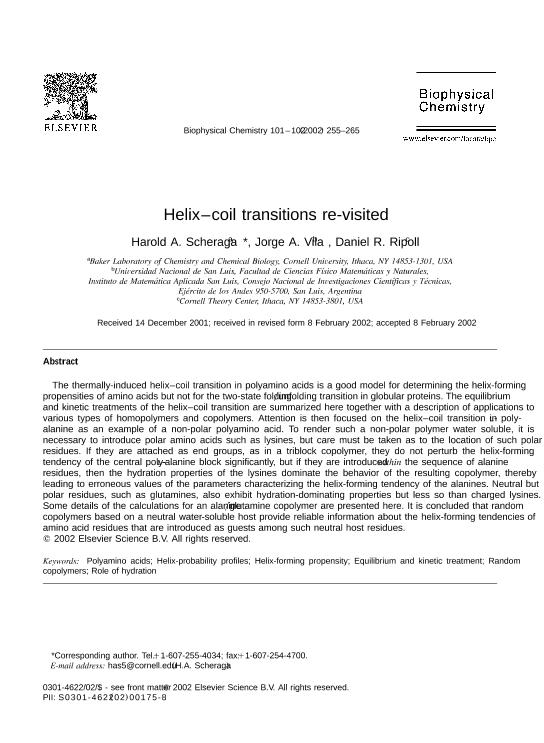Artículo
Helix-coil transitions re-visited
Fecha de publicación:
12/2002
Editorial:
Elsevier Science
Revista:
Biophysical Chemistry
ISSN:
0301-4622
Idioma:
Inglés
Tipo de recurso:
Artículo publicado
Clasificación temática:
Resumen
The thermally-induced helix-coil transition in polyamino acids is a good model for determining the helix-forming propensities of amino acids but not for the two-state folding/unfolding transition in globular proteins. The equilibrium and kinetic treatments of the helix-coil transition are summarized here together with a description of applications to various types of homopolymers and copolymers. Attention is then focused on the helix-coil transition in poly-L-alanine as an example of a non-polar polyamino acid. To render such a non-polar polymer water soluble, it is necessary to introduce polar amino acids such as lysines, but care must be taken as to the location of such polar residues. If they are attached as end groups, as in a triblock copolymer, they do not perturb the helix-forming tendency of the central poly-L-alanine block significantly, but if they are introduced within the sequence of alanine residues, then the hydration properties of the lysines dominate the behavior of the resulting copolymer, thereby leading to erroneous values of the parameters characterizing the helix-forming tendency of the alanines. Neutral but polar residues, such as glutamines, also exhibit hydration-dominating properties but less so than charged lysines. Some details of the calculations for an alanine/glutamine copolymer are presented here. It is concluded that random copolymers based on a neutral water-soluble host provide reliable information about the helix-forming tendencies of amino acid residues that are introduced as guests among such neutral host residues.
Archivos asociados
Licencia
Identificadores
Colecciones
Articulos(IMASL)
Articulos de INST. DE MATEMATICA APLICADA DE SAN LUIS
Articulos de INST. DE MATEMATICA APLICADA DE SAN LUIS
Citación
Scheraga, Harold A.; Vila, Jorge Alberto; Ripoll, Daniel R.; Helix-coil transitions re-visited; Elsevier Science; Biophysical Chemistry; 101-102; 12-2002; 255-265
Compartir
Altmétricas




